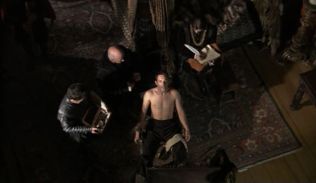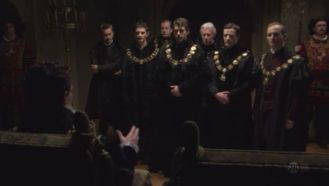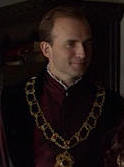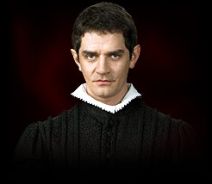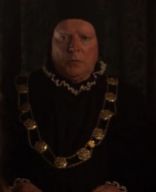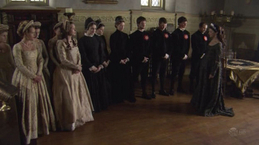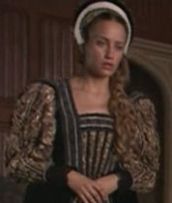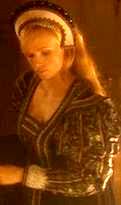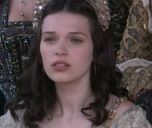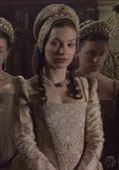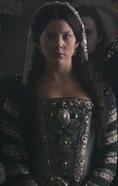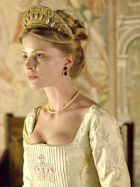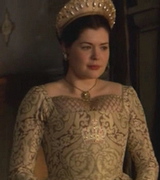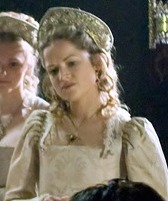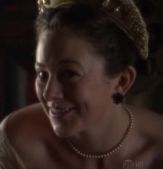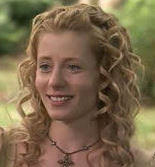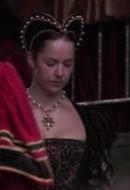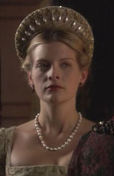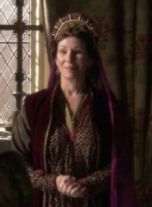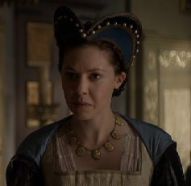COURT of the King
Jump to navigation
Jump to search
LINKS:
| ||
INTERESTING FACTS:
| ||
| The King's Household of approximately 500 people had 2 departments: | ||
| 1. "The Chamber" or domus magnificentiae which was the household above stairs & was run by the Lord Chamberlain (the most important figure at court). He was in charge of all court entertainments, he supervised distribution of lodgings in the palace, made arrangements for the king´s progresses, received the Ambassadors and other visitors to the court, and conducted them into the royal presence. | ||
| 2. The Household proper or domus providentiae which was the household below stairs & was under the supervision of the Lord Steward whose concern was the material and mundane necessities of the monarch and of his court such as food, drink, lighting and fuel. | ||
| "Being the personal household of the King, the court was organized like any private residence. It was infinitely larger, vastly more chaotic, and teeming with intrigues and violence, but structurally [the same]... The immediate area surrounding the sovereign, his privy chamber, was referred to as the above stairs of the household. Over it presided the lord chamberlain, who attended to the personal wants of the King and organized the ponderous ceremony which encircled his royal person, protecting him and gracing his every action with the divine dignity that doth hedge about a king. Below stairs was the domain of the lord steward, who was responsible for the domestic needs of the entire staff. Under him was an army of domestics ranging in importance from the controller, the four masters of the household, the master of the jewels, and the King s fool, down to the children of the scullery, the apprentice cooks of the kitchen, and the groom of the stool. The division between the two parts of the household was essentially that of the master's suite versus the servants quarters, but the distinction between the two tended to become blurred on the upper levels. In many baronial homes the steward or chamber lain was often a relative of the family; so at court, the high officials of the house, though they performed duties below stairs, socially belonged to the upper household. " ~ Lacey Baldwin Smith in A Tudor Tragedy |
| Lord Steward |
 Charles Brandon, 1st Duke of Suffolk held a succession of offices in the Royal Household, including Master of the Horse, Lord President of the Council and Lord High Steward (not to be confused with Lord Steward). Charles Brandon, 1st Duke of Suffolk held a succession of offices in the Royal Household, including Master of the Horse, Lord President of the Council and Lord High Steward (not to be confused with Lord Steward).The office of Lord Steward was one of considerable political importance as it carried cabinet rank. The Lord Steward receives his appointment from the King in person, and bears a white staff as the emblem and warrant of his authority. He is the first dignitary of the court. In an act of King Henry VIII (1539) for placing of the lords, he is described as the grand master or lord steward of the king's most honourable household. The Lord Steward or his deputies administered the oaths to the members of the House of Commons. In certain cases (messages from the sovereign under the sign-manual) the lords with white staves are the proper persons to bear communications between the Sovereign and the Houses of Parliament. "In theory, the professional activities of the lord steward were multitudinous and endlessly varied. He catered for the needs and peculiarities of the entire entourage. He saw to the feeding of strangers and to the exclusion of boys and vile persons ; he insisted that members of the court eat at the prescribed hour and place; he disbursed 'bouche of court' or the daily ration of bread, beer, wine and faggots allotted to gentlemen and ladies and upper- class servants, according to their rank and service. One of the lord steward's most vexing and complex tasks was the feeding of this hungry army of courtiers, maidens and domestics in an age when both sexes ate prodigiously, at length, and with vast ceremony. The gastronomic well-being of English men in the sixteenth century was proverbial, and rarely did a foreign traveller refrain from commenting upon the fact that farmers and yeomen ate almost as well as gentlemen and nobles. ...The officers of the household were strictly commanded to search for strangers at meal-times and for rascals and vagabonds who were constantly creeping into the system and passing them selves off as servants of the Crown. Efforts to achieve a certain degree of economy and system were not limited to denying food and board to those who had no right at court. Strenuous, if not always successful, attempts were made to curb the number of menials who surrounded every person of rank. Labour shortage was still a curse of the future, and every gentleman or nobleman was waited upon by a clamorous throng of hangers-on who endured a hungry existence on the periphery of a great man's following. The desire to keep servants had more to do with prestige than with service, and if the court regulations had not strictly limited the number, the household would have been hope lessly jammed. The allocation was carefully made according to status. The King's councillors, the lord chamberlain, the captain of the guard and the master of the horse, plus the six gentlemen of the privy chamber were each allowed to keep one page to attend upon the court so that always he be a gentleman born, well mannered and apparelled, and well conditioned. Other more lowly-born servants were ordered to remain in town or else where out of the court , and sergeants-at-arms, heralds, messengers, minstrels, falconers, and the like were commanded not to bring boys, rascals, or others of their servants into the court on pain of severe fine and possible expulsion. " ~ Lacey Baldwin Smith in A Tudor Tragedy |
| The King's Chamber was also divided into 2 areas : |
| 1. The Privy Chamber was the most influential department in the royal household. It housed the king's "privy lodging", consisting of the bedroom, library, study, and of course, the toilet with a regular staff of its own, such as gentlemen, ushers, grooms, and pages. Also other specialized officers of the chamber were the monarch's secretary, chaplain, physician, surgeon, apothecary, barber, henchmen or young gentlemen in attendance under their master, and finally, the Esquires of the Household. |
| 2. The Outer Chamber (often styled presence chamber), and the great hall. |
| "The closer to the royal presence, the greater the degree of elaborate ceremony, until one reached the epitome of pompous regulation in the organization of the King s privy chamber. The number of individuals who could claim entrance into the inner sanctum of the royal presence was rigidly limited and defined. The monarch was to be waited upon by six gentlemen, two gentlemen ushers, four grooms, a barber, and a page, all of whom were appointed for their good behaviour and qualities , and who diligently attended upon the royal person, doing humble, reverent, secret, and lowly service . The grooms of the chamber were not to lay hands upon the royal person or intermeddle with preparing or dressing the King. This responsibility was the much sought-after task of the gentlemen of the bedchamber, who received the royal clothes at the door of the inner chamber after they had been carefully warmed before the fire. Later in the reign the size of the entourage about the King was more than doubled to allow these well-born servants a certain degree of relief from their constant vigilance and domestic cares. Equally intricate was the process by which the royal bed was prepared each morning. Both the straw mattress and the box of the bedstead had to be rolled upon by one of the yeomen of the bedchamber to test it for hidden daggers. On top of the mattress was laid a canvas cover and feather bed, which again was tested for treacherous objects . Finally came embroidered sheets and soft blankets until all was completed except the concluding ceremonial flourish of placing the King's sword at the head of the bed while each of the four yeomen kissed the places where their hands had touched the royal couch." ~ Lacey Baldwin Smith |
| This title was an amalgamation of Esquires of the Household and the Knights of the Body. The Privy Chamber became a separate household department under the command of one of the two chief gentlemen who also assumed the title of the Groom of the Stool. The primary duty of the groom of the stole (or stool) was to see that "the house of easement be sweet and clear". He, however, emerged eventually as the manager of the privy chamber as well as the privy purse. The gentlemen were assisted by the grooms of the privy chamber who, under the supervision of the gentlemen ushers, attended to the cleanliness of the rooms.The Statutes of Eltham of 1526 provided for 6 gentlemen, 2 gentlemen ushers, 4 grooms, a barber, and a page, "whom the King's grace for their good behaviour and quallityes hath elected for that purpose" (14 people). As salary a gentleman received £50 a year, a gentleman usher £30, and a groom £20. Every esquire was entitled to 5 horses whereas every groom to 2 horses. |
| Grooms of the Stool/Stole See also : Worst Jobs in Tudor Times (Part 2) |
| The title originally referred to the chamberpot (or stool) of the king. Later it came to represent the long robe of the Monarch (from the Latin stola, meaning garment). This especially prized title was awarded to sons of noblemen or important members of the gentry. As minions of the King & close court companions they would spend quality time with him and it allowed them unobstructed access to the King's attention. Among other administrative duties of the privy chamber, they had the task of cleaning the Monarch's rear. Henry's successor Edward VI abolished the title. "...the description of the materials used in the construction of Henry VllI's close-stool. It ..was covered in black velvet, stuffed with three pounds of down for the seat, arms and side, and was held together with 2,000 gilt garnishing nails and 26 bullion nails, but no matter how it was decorated, it still remained a chamber-pot" ~Lacey Baldwin Smith in A Tudor Tragedy |
| Sir William Compton | Sir Henry Norris |
| The King's Secretary | The King's Physician |
| £50 a year | |
| |
| <embed allowfullscreen="true" height="344" src="http://widget.wetpaintserv.us/wiki/thetudorswiki/widget/youtubevideo/1304bfbfeea6f2f0e88f966f50f41d41eeaf794a" type="application/x-shockwave-flash" width="425" wmode="transparent"/> Made as part of HISTORY's Henry Week which featured the premieres of two new shows: Inside The Body of Henry VIII; and Inside The World of Henry VIII. Further details here: <a class="external" href="http://tinyurl.com/mg4dz3" rel="nofollow" target="_blank" title="http://tinyurl.com/mg4dz3">http://tinyurl.com/mg4dz3</a> [source : <a class="external" href="http://www.youtube.com/user/HistoricRoyalPalaces" rel="nofollow" target="_blank">HistoricRoyalPalaces</a> April 02, 2009] |
| The Queen's Household paralleled the King's but smaller approximately 150 - 250 people |
| The queen had her own council, whose members, all male, performed such practical tasks as directing & supervising the care of her extensive properties. She had her own Lord Chancellor, her master of the horse, her secretary, her chaplain & a host of male servants, as well as needlewomen, chamberers and ladies. |
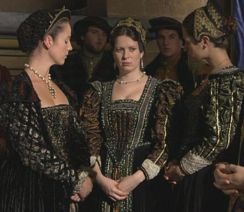 Ladies-in-waiting were divided into 4 separate caste systems - Ladies-in-waiting were divided into 4 separate caste systems -
|
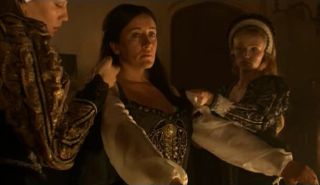 The Great Ladies functioned in infrequent, chiefly ceremonial roles, while the Ladies of the Privy Chamber were especially privileged in seeing to the queen's most intimate needs as she readied herself for bed and prepared for the intricate task of getting dressed in the morning. Maids of Honour were young unmarried women who attended the queen, learning the ways of court and there attracting the attention of the King's most eligible courtiers. Mothers among nobility fought long and hard to get their marriageable daughters positions as Maids of Honour. The last category, the Chamberers were the most humble of the queen's personal female servants. The Great Ladies functioned in infrequent, chiefly ceremonial roles, while the Ladies of the Privy Chamber were especially privileged in seeing to the queen's most intimate needs as she readied herself for bed and prepared for the intricate task of getting dressed in the morning. Maids of Honour were young unmarried women who attended the queen, learning the ways of court and there attracting the attention of the King's most eligible courtiers. Mothers among nobility fought long and hard to get their marriageable daughters positions as Maids of Honour. The last category, the Chamberers were the most humble of the queen's personal female servants. |
| Duties were to accompany the King & Queen in hunting, hawking parties & elaborate masquerades. They were expected to attend frequent jousts, contests that also served as military training for courtiers and to applaud the contestants. Indoors, they could be found playing cards, reading (mostly religious works), playing music & attending chapel. (Queen Katherine of Aragon would spend hours each day praying & her ladies prayed as well). Sewing was almost an obsession among female members of court.The queen & her ladies could be found working on elaborate costumes for balls & masquerades, in times of war, making standards, badges & banners and at other times making clothing for the poor. However, it must be remembered that being a lady-in-waiting was a job just like any other. |
| "At a time when virtually every profession was exclusively a male preserve, the position of Lady-in-waiting to the queen was almost the only occupation that an upper class Englishwoman could with propriety pursue... Any lady at court with a position could feel she had a finger on the pulse of power, even if in most cases she could not determine the rate at which it beat" [source: <a class="external" href="http://books.google.ca/books?hl=en&id=b06C-PVZ9LgC&dq=ladies+in+waiting&printsec=frontcover&source=web&ots=N5pw2-DDYB&sig=EZ6udQlpHoad97SwFk9fsPDSVDw&sa=X&oi=book_result&resnum=6&ct=result#PPA28,M1" rel="nofollow" target="_blank" title="Anne Somerset's "Ladies in Waiting"">Anne Somerset's "Ladies in Waiting"</a>] |
| Women who performed their tasks in the queen's household successfully & possessed valuable social skills retained their positions during multiple reigns & served successive queens & royal children. -Anne Boleyn served Queen Katherine of Aragon & Queen Claude. -Jane Seymour served Queen Katherine of Aragon & Anne Boleyn. -Jane Boleyn, Lady Rochford served, Katherine of Aragon, Anne Boleyn, Anne of Cleves & Katherine Howard. -Margery Horsman served Queen Katherine of Aragon, Anne Boleyn & Jane Seymour. -Lady Margaret Bryan served Queen Katherine of Aragon & was governess to all 3 of Henry's children. -Katherine Howard served Anne of Cleves. - Anne Parr, Lady Herbert served Queen Katherine of Aragon, Anne Boleyn, Jane Seymour, Anne of Cleves, Katherine Howard and Catherine Parr |
| Ladies-in-waiting |
| "Bessie Blount earned 100s a year when she was first appointed maid of honour. Before she left for court, her family would have ensured that she had a wardrobe full of garments far more expensive than her meagre salary would allow. She would serve the queen's dinner but might also be invited to go hunting and hawking with the royal couple,star in masquerades, cheer the participants at competitions and attend numerous feasts and festivities. The ladies might gamble at cards, deliver messages for the queen or start a flirtation with one of the king's men; their precise role depended on the present queen, but they were always at the centre of court life." ~ Kelly HartThe Mistresses of Henry VIII (2009) |
| | Lady Jane Howard/Slaine Kelly fictional character possibly based on Jane Popyngcort, who attended Queen Katherine of Aragon | |
| | ||
| based on Mary Shelton who attended Anne Boleyn | almagation of a couple of ladies who attended Anne Boleyn | |
| attended Queen Katherine of Aragon | fictional character attended Queen Katherine of Aragon | Eleanor Luke/Andrea Lowe fictional character based on an "unknown lady" who attended |
| A "great lady" who attended Princess Mary Tudor as governess | 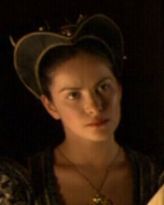 Lady Manuela/ Sonya Macari fictional character attended Queen Katherine of Aragon | 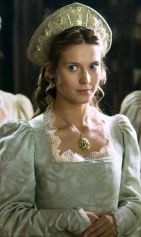 Ursula Misseldon/ Charlotte Salt fictional character attended Jane Seymour |
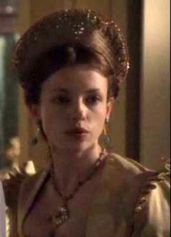 Anne Parr/ Suzy Lawlor in reality attended every queen from Queen Katherine of Aragon to Catherine Parr (in the series only) | attended Katherine Howard | 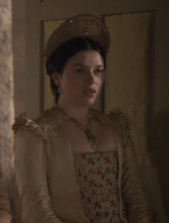 Elizabeth Fitzgerald/ Gemma-Leah Devereux attended Katherine Howard and Catherine Parr |
SOURCES:
|
Lists of the names of the Ladies in each Queen's household *entries under maiden names compiled in<a class="external" href="http://www.kateemersonhistoricals.com/TudorWomenIndex.htm" rel="nofollow" target="_blank" title="Kathy Lynn Emerson`s Who`s who of Tudor Women">Kathy Lynn Emerson`s Who`s who of Tudor Women</a> |
| Household of Queen Katherine of Aragon In 1509: 147-160 persons, including 33 aristocratic women (18 wives or daughters of peers) Ladies in Waiting (8): *Anne Hastings, Countess of Derby *Anne Hastings, Countess of Shrewsbury Mary Say, Countess of Essex Elizabeth Scrope, Countess of Oxford *Margaret Scrope, Countess of Suffolk *Anne Stafford, Lady Hastings *Elizabeth Stafford, Lady Fitzwalter *Agnes Tylney, Countess of Surrey replacements by 1517: *Maud Green, Lady Parr *Elizabeth Howard, Lady Boleyn *Margaret Plantagenet, Lady Pole *Joan Vaux, Lady Guildford Ladies of the Bedchamber (8) Anne Bourchier, Lady Dacre of the South Margaret Brent, Lady Bergavenny Mabel or Margaret Dacre, Lady Scrope Mary Grey, Lady Ferrers of Chartley Lady Percy Lady Maltravers *Inez de Venegas, Lady Mountjoy (Lord Mountjoy’s 2nd wife) Maids of Honor (over the period 1509-1536): *Dorothy Badby *Elizabeth Blount *Gertrude Blount *Anne Boleyn *Joan Champernowne *Elizabeth Darrell *Margery Horsman *Mary Norris *Jane Popyngcort *Maria de Salinas *Jane Seymour *Anne Stanhope *Lucy Talbot *Mary Zouche in unspecified positions: *Margaret Bourchier, Lady Bryan *Mabel Clifford, Lady FitzWilliam Elizabeth Ferrers Catherine Hussee, Lady Bray *Anne Jerningham Anne Knyvett Mrs. Marzen Anne Percy, Countess of Arundel *Eleanor Pole, Lady Verney *Eleanor Radcliffe, Lady Lovell Mary Roos, Mrs. Denis/Denys Anne Sandys, Mrs. Weston Elizabeth Scrope, Lady Pechey *Mary Scrope, Lady Jerningham (later Lady Kingston) *Margaret Wotton, Marchioness of Dorset Ladies living at court in participating in revels 1517-1518: *Elizabeth Blount *Anne Brown Margaret Bruges *Elizabeth Bryan, Lady Carew *Margaret Bryan, Lady Guildford Anne Carew (unmarried sister of Nicholas) ___ Dannett *Mary Fiennes *Alice Kebel, Lady Mountjoy (Lord Mountjoy’s 3rd wife) Lady St. Leger *Elizabeth Stafford, Countess of Surrey Anne Weston *Mary Wotton | Anne Boleyn’s Household It is estimated that Anne had approximately 60 Ladies-in-waiting (& 250 servants) Including: Ladies in waiting: Anne (Nan)Saville Margaret Dymoke Honor Grenville Elizabeth Holland (Bessie) The Duke of Norfolk's mistress Mary Scrope Elizabeth Wood, Lady Boleyn (wife of her uncle James Boleyn) Margaret Wyatt, Lady Lee Mary Wyatt Bridget Wiltshire, Lady Wingfield Lady Worcester - who gave evidence against Anne Jane Boleyn, nee Parker, Viscountess Rochford- also gave evidence against Anne Maids of Honor: *Anne Gainsford *Margery Horsman *Lady Mary Howard *Elizabeth Holland *Mary Norris *Jane Seymour *Margaret Shelton (Madge Sheldon) *Mary Zouche Anne (Nan) Cobham - witnessed against Anne Mistress Stonor Mistress Cosyns |
| Jane Seymour’s Household Maids of Honor: *Jane Arundell *Mary Arundell *Jane Ashley *Anne Bassett *Margery Horsman *Elizabeth Jerningham *Mary Norris *Anne Parr *Mary Zouche Mother of Maids: *Margaret (or Anne) Foliot, Mrs. Stonor Chief Chamberer: Mrs. Fitzherbert in unspecified positions: *Mary Brandon, Lady Mounteagle *Elizabeth Oxenbridge Jane Boleyn, Lady Rochford *Eleanor Paston, Countess of Rutland Queen Jane’s Funeral Procession First Chariot: *Mary Arundell, Countess of Sussex *Frances Brandon, Marchioness of Dorset *Mabel Clifford, Countess of Southampton Cecily Daubeney, Countess of Bath *Lady Margaret Douglas *Eleanor Paston, Countess of Rutland Elizabeth Trussell, Countess of Oxford Second Chariot: *Elizabeth Bryan, Lady Carew Lady Margaret Grey *Jane Parker, Lady Rochford Dorothy Howard, Countess of Derby On Horseback: *Alys Gage, Lady Browne *Jane Guildford, Lady Dudley *Anne Sapcote, Lady Russell Alice St. John, Lady Morley and others Third Chariot: *Anne Bray, Lady Cobham *Margaret Dymoke, Lady Coffin *Jane Hallighwell, Lady Bray *Mary Scrope, Lady Kingston Riding: *Elizabeth Harleston, Lady Wallop *Margery Horsman, Lady Lister *Anne Pickering, Lady Knyvett Catherine Skipwith, Lady Heneage others Fourth Chariot: *Jane Ashley, Mrs. Mewtas *Elizabeth Holland *Mary Norris *Anne Parr *Mary Zouche Riders: *Elizabeth Seymour, Lady Cromwell others Fifth Chariot: *Anne Bassett Mrs. Fitzherbert *Dorothy Gates, Mrs. Josselyn Mrs. Rastell Mrs. Uxbridge | Anne of Cleves’s Household Great Ladies of the Household *Mary Arundell, Countess of Sussex *Frances Brandon, Marchioness of Dorset *Lady Margaret Douglas *Elizabeth Grey, Lady Audley *Mary Howard, Duchess of Richmond *Eleanor Paston, Countess of Rutland Privy Chamber: *Lady Edgecumbe *Jane Guildford, Lady Dudley *Susanna Hornebolt, Mrs. Gilman *Isabel Legh, Lady Baynton Jane Boleyn, Lady Rochford Gentlewomen in Attendance: *Jane Ashley, Lady Mewtas *Jane Cheney, Lady Wriothesley *Jane Guildford, Lady Dudley *Elizabeth Seymour, Lady Cromwell Catherine Skipwith, Lady Heneage Maids of Honor (6) *Anne Bassett *Dorothy Bray *Catherine Carey *Catherine Howard *Mary Norris *Ursula Stourton Mistress of the Queen’s Maids: Mother Lowe *Margaret (or Anne) Foliot, Mrs. Stonor |
Katherine Howard’s Household Great Ladies of the Household (6): Ladies of the Privy Chamber: *Lady Edgecombe *Isabel Legh, Lady Baynton Jane Boleyn, Lady Rochford *Eleanor Paston, Countess of Rutland Chamberers: Joan Bulmer nee Acworth Margaret Morton Alice Restwold Katherine Tylney Gentlewomen Attendants: Lady Margaret Arundell *Mary Arundell, Countess of Sussex *Joan Champernowne, Lady Denny *Lady Margaret Douglas *Margaret Gamage, Lady Howard *Dorothy Gates, Lady Josselyn *Elizabeth Oxenbridge, Lady Tyrwhitt *Mary Howard, Duchess of Richmond *Elizabeth Seymour, Lady Cromwell *Ursula Stourton, Lady Clinton *Agnes Tylney, Dowager Duchess of Norfolk Maids of Honor: *Anne Bassett *Dorothy Bray ___ Cowpledike *Elizabeth Fitzgerald? ___ Garnish/Garneys *Mary Norris *Lucy Somerset *Catherine Stradling Mother of Maids: *Margaret (or Anne) Foliot, Mrs. Stonor | Catherine Parr’s Household There were 33 aristocratic women in Katherine’s household, including t10 married to peers. These occasionally included Henry VIII’s two daughters and 3 nieces. The household in 1547 included 27 ladies ordinary and 8 queen’s maids. Great Ladies of the Household and members of the queen's "inner circle": *Joan Champernowne, Lady Denny *Lady Margaret Douglas *Anne Calthorpe, Countess of Sussex *Jane Guildford, Lady Lisle *Anne Stanhope, Lady Hertford Gentlewomen of the Privy Chamber (6); Gentlewomen of the Bedchamber: *Elizabeth Oxenbridge, Lady Tyrwhitt *Maud Parr, Lady Lane *Mary Wotton, Lady Carew Chamberers (6): *Dorothy Fountain ___ Osborne (daughter of Edward Osborne) *Mary Woodhull Maids of Honor: *Anne Bassett *Dorothy Bray Sir Anthony Browne’s daughter a Carew a Guildford a relative of Dr. Robert Huicke a Windsor Mother of Maids: *Margaret (or Anne) Foliot, Mrs. Stonor Paintrix: *Lavina Bening, Mrs.Teerlinck in unspecified positions: Mistress Barbara ___ *Mary Arundell, Countess of Arundel *Elizabeth Bellingham, Mrs. Hutton Anne Blechingham or Blechington *Eleanor Browne, Lady Kempe *Elizabeth Fitzgerald, Mrs. Garrett *Anne Jerningham, Lady Walsingham *Margery Horsham, Lady Lister Dr. Robert Huicke’s wife? Mistress Kendal *Margaret Neville *Anne Sapcote, Lady Russell *Lucy Somerset *Elizabeth Stonor, Lady Hoby Mistress Syllyard Catherine Brandon, Duchess of Suffolk |
Households of the Princesses |
| Household of Princess Mary Tudor, Henry VIII’s daughter Lady Mistress: *Elizabeth Jerningham, Mrs. Denton (1516) *Margaret Bourchier, Lady Bryan *Margaret Plantagenet, Countess of Salisbury(1519; 1525; 1533) *Amata (Jane) Boleyn, Lady Calthorpe (1522) Nurse: *Catherine Brydges, Mrs. Pole Laundress: Avis Wood (1516) Beatrice ap Rhys (wife of David ap Rhys, groom) (1519-1558) The household in 1525 at Ludlow Castle included: in unspecified positions: Alice Baker Cecily Dabridgecourt Mary Dannett Anne Darnell ____ de Bruxia (wife of Peter) Frances Elmer Mary Ferdnando Mary Fitzherbert (1526) *Lady Catherine Gordon Anne Read or Rede Mary Victoria Chamberers: ____ Baptist Helen Gwyn Alice Parker 1533: Mary Browne ___ Butts *Lady Margaret Douglas ____ Duwes (Mrs. Giles) Katherine Grey, Lady Maltravers ____ Rider 1536: Forty two people in all, including: *Frances Baynham Mary Baynton *Eleanor Browne, Lady Kempe Mary Brown Frances Elmer Mary Finch *Elizabeth Fitzgerald Barbara Hawke Frances Jerningham *Anne Morgan Elizabeth Sidney *Susan White 1543: *Anne Parr, Lady Herbert *Catherine Parr, Lady Latimer 1547: Chamberers: Cecily Barnes *Frideswide Knight Silkwoman: Marie Wilkinson Fool: *Jane Tumbler: *Lucretia | Princess Elizabeth Tudor’s Household after 1536: Lady Mistress: *Blanche Milborne, Lady Troy, Governess: *Katherine Champernowne (Kat Ashley) *Elizabeth Oxenbridge, Lady Tyrwhitt in miscellaneous positions: Elizabeth Cavendish *Frances Edmonds *Elizabeth Garrett *Honora Grey *Mary Hill *Isabella Markham Mary Norris *Elizabeth Norwich *Blanche Parry *Anne Rede (married to Thomas Parry) *Mary St. Loe *Elizabeth Sandes *Bridget Skipwith *Elizabeth Venables, Mrs. Marbery *Margaret Willoughby chamberers: Jane Bradbelt (see Dorothy Broadbelt) Alys Huntercrum laundress: Agnes Hylton with Elizabeth in the Tower of London (1554) Blanche Courtenay *Ethelreda Malte, Lady Harington *Blanche Parry *Elizabeth Sandes |
